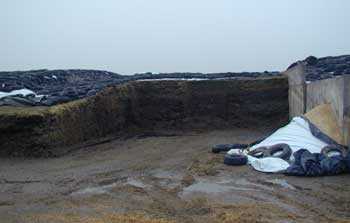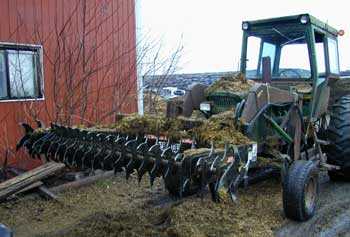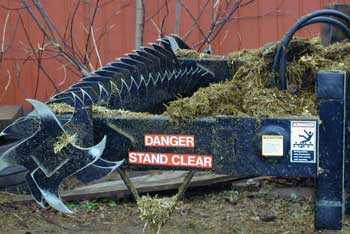Teenage Farm Worker Dies during Silage Defacer Entanglement
New York Case Report 05NY001
Summary
On January 2nd, 2005 an 18-year-old farm worker was fatally injured when he became entangled in a silage defacer, which loosens and collects silage to add to a feed mix wagon. At the time of the incident, the worker was idling a tractor to allow it to warm up prior to use on a cold morning. The silage defacer was attached on the front of the tractor, approximately four feet off the ground. The worker energized the defacer unit while the tractor was idling near the farm shop, then proceeded to do some work in the shop area, and while doing this walked in front of the energized defacer unit. The sleeve of the victim’s coat became caught in the unit and he became entangled around the moving parts of the machine. The farm owner, who was working nearby in the farm shop, heard an unusual sound and went to investigate. Upon arriving at the scene, he immediately turned off the power to the defacer unit, shut off the tractor engine and then called 911. The farmer disentangled the victim from the machinery and began CPR until a local EMT arrived. Shortly after, the rescue squad and state police arrived. The victim was subsequently pronounced dead at the scene.
New York State Fatality Assessment and Control Evaluation (NY FACE) investigators concluded that to help prevent similar incidents from occurring in the future:
- Silage defacers and other powered equipment attachments on tractors should only be energized while the operator is in the machine operator position;
- Workers should not come in close proximity to operating pieces of equipment such as defacers or other machines with aggressive entanglement points and;
- Employers should ensure that all operators of equipment are thoroughly trained on hazardous pieces of equipment and ensure employees follow safe operating procedures.
Additionally, equipment manufacturers should consider:
- Incorporating automatic shut off features into equipment designs such that when the operator leaves the operator seat position, the equipment deenergizes and;
- Adding bright-colored paint and/or stripes on the front side wheels of defacer units to increase equipment visibility.
Introduction
On January 2nd, 2005 an 18-year-old Caucasian male farm worker was fatally injured when he became entangled in a silage defacer. NY FACE staff learned of the incident on January 3rd through a call from an area Occupational Safety and Health Administration (OSHA) office. At the time of the incident, the victim was operating a tractor with a silage defacer attachment in preparation for loosening and collecting silage to add to a feed mix wagon.
A NY FACE investigator visited the farm on January 4th, spoke with the farm owners, and inspected the incident location and equipment involved in the incident. The investigator also reviewed news reports and spoke with the medical examiner’s office and the NY State Police Investigator who worked on the case.
The victim, a nephew of the farm owner, had worked on the farm for the past four years. This dairy farm consisted of 1200 acres of cropland and approximately 300 head of cattle. The victim initially worked on the farm feeding calves, eventually began milking the cows, and progressed to learning how to operate equipment and perform some of the equipment work on the farm. Prior to the incident, the victim had used this silage defacer occasionally, and had used it each of the three days prior to the incident. The victim reportedly was a conscientious worker who had previously exhibited very safe working skills.
Back to Top
Investigation
On Sunday, January 2nd, 2005, the 18-year-old farm worker arrived at the farm slightly before 6:00 a.m. He began to collect feed from the corn silage bunker and prepare the feed for distribution to the dairy cattle. In order to do this, the first step was to loosen and remove silage from the bunker silo face.
A bunker silo is a concrete structure that is set horizontally in the ground and has a concrete base and walls with an open top. Silage is placed and packed in this bunker, then covered with plastic until it is used. As it is used, the material is removed from the front of the silage bunker towards the back. The cover on the top of the bunker is moved back to the removal level of the silage (Figure 1). A payloader or a front-end loader on a tractor is commonly used on dairy farms to scoop up silage from the silage face and place it in a feed mixing wagon. A newer technology that farms have begun to use is a piece of equipment called a silage defacer. This unit attaches to either the front of a payloader or an agricultural tractor. Lift arms allow the defacing unit to be moved vertically up and down. The unit has large rotating wheels with teeth on them that remove a slice of silage. Typically, these teeth remove about 6 inches of material from the face vertically each time (Figure 2). The unit is placed in the uppermost position and shaves off a section of the silage face allowing the material to fall to the base of the silage bunker. A payloader then scoops the silage and places it in a feed mixing wagon. A defacer is used to allow a clean slice to be removed and a uniform face to be maintained, which prevents additional spoilage by reducing the surface area of silage exposed to the elements. Additionally, this reduces the potential for overhangs and unstable silage faces to form, which have been known to collapse and entrap workers.
 |
 |
Figure 2. Silage defacer involved in the incident. |
As the young worker began his chores on the morning of the incident, he started a John Deere 4020 tractor that had the front-end loader arms attached and a silage defacer mounted on the arms. The silage defacer was manufactured by Frontier Equipment Company and was approximately four years old. The farm had no previous safety or operational problems with this defacer, and it was properly marked with warning signs, warning operators to stand clear of the equipment (Figure 3).
 |
Figure 3. Silage defacer warnings. |
The John Deere tractor involved in the incident had a diesel engine, which in cold weather required a block heater to warm it up before trying to start the engine. This tractor’s block heater had been plugged in via an electric extension cord from the farm shop, which was then unplugged, coiled up and hung on a hook in the farm shop before the victim proceeded to start the engine of the tractor. After starting the tractor, the young worker allowed the tractor to warm up more by having the engine idle. For an unknown reason, the victim energized the hydraulic control lever that supplied energy to the defacer unit, which was powered by hydraulic fluid. The on-off lever for the hydraulic system was on the right hand side of the operator seat. The young man energized the defacer with the unit raised approximately four feet above the ground. It is unknown why the victim turned on the power to allow the defacer to operate. The defacer did not require any pre-maintenance or lubrication prior to its’ operation. This farm has had a very good safety record and has always stressed safety with their workers including offering worker-training programs. For this particular defacer unit, it was reportedly stressed that the unit should only be energized when the operator was on the tractor and the tractor was in position; otherwise the unit should not be on. It had not been previously observed that any of the workers, including the victim, had ever energized the defacer unit when the tractor was not in position in the bunker silo.
As the tractor engine was warming up and the defacer unit was running, the victim dismounted the tractor and walked around in front of the unit. As he was going around the front right hand corner of the unit, the outside defacer wheel caught the right hand shoulder material of his jacket. When the teeth on the wheels caught the jacket material, the victim became entangled around the rotating defacer unit. The victim rotated around the unit and struck both the ground and the front fender of a Mac Aerodyne truck that was parked in front of the defacer unit.
At the time of the incident, the farm owner was in a nearby building. He heard an unusual noise, which he thought may have indicated a broken piece of equipment. He went to the incident location to see if he could assist the worker in fixing this piece of equipment. Upon finding the victim, he immediately turned off the power to the defacer unit and shut off the tractor engine. He called 911, cut the jacket fabric loose from the defacer, removed the young man from the entanglement and laid him on the ground and began to perform CPR. He went back to the phone to report to the 911 operator that there were no visible signs of life. He tried a second time to perform CPR on the victim, and at that point a local EMT arrived on the scene. The EMT took over the resuscitation attempts from the farm owner. The local rescue squad and the State Police then arrived at the scene. The victim was subsequently pronounced dead at the scene.
In reconstructing the incident, there is no evidence that the victim had been attempting any maintenance or repair activities. It is believed that he was simply warming up the tractor and may have energized the defacer unit thinking that it needed to be warmed up also. It is believed that the victim was simply walking past this unit going back into the shop at the time of the entanglement due to the location of entanglement on the outside right shoulder/arm of his Carhartt jacket. It is not believed that he was underneath the unit or trying to work on this piece of equipment. The defacer wheels are designed to aggressively remove silage from a compacted state. This piece of equipment was intended to be energized only when it is in place in front of the silage face. Since it is designed to remove organic silage material, the machinery cannot have guards that would prevent contact from the wheels in this type of scenario. Typically, worker protection for this type of unit would be achieved by having the operator safely in position in the operator’s seat. Normally, this defacer would be 12 feet above the ground working its way down to ground level while the operator is in the tractor operator position.
Back to Top
Cause of Death
The official cause of death was listed by the Medical Examiner as cerebral edema and blunt trauma.
Recommendations/Discussion
Recommendation #1: Silage defacers and other powered equipment attachments on tractors should only be energized while the operator is in the machine operator position.
Discussion: In this situation the worker had energized the unit and left it running while he left the operator position. Silage defacers are intended to be energized only when they are in place in front of a silage face. The unit does not present an entanglement hazard to the operator when the operator is safely in position in the operator’s seat.
Recommendation #2: Workers should not come in close proximity to operating pieces of equipment such as defacers or other machines with aggressive entanglement points.
Discussion: This particular piece of equipment has very aggressive blades similar to a circular saw blade that has large protruding metal teeth. This is necessary for the equipment to remove silage from a compacted state. Entanglement zones of this type should be avoided. The silage defacer involved in the incident had clear warning signs very visibly placed on the unit communicating to workers that they should stay clear of the unit.
Recommendation #3: Employers should ensure that all operators of equipment are thoroughly trained on hazardous pieces of equipment and ensure employees follow safe operating procedures.
Discussion: In this situation, although the victim was trained on this unit he left the unit energized and left the operator position. Employers should periodically provide refresher training to workers and ensure that safe operating procedures are followed.
Recommendation #4: Equipment manufacturers should consider incorporating automatic shut off features into equipment designs such that when the operator leaves the operator seat position, the equipment deenergizes.
Discussion: An attachment such as a defacer can be attached to many types of equipment including agricultural tractors and industrial payloaders. Many newer payloaders have seat switches built into their design that automatically shut-off the power to hydraulic attachments if the operator leaves the operator seat. Equipment manufacturers should explore the feasibility of adding/installing additional seat safety switches to retrofit kits that would de-energize a unit should the operator leave the operator position. This would be especially useful when retrofitting kits onto older equipment that may not have certain safety features built into their original design.
Recommendation #5: Manufacturers of silage defacers should consider adding bright-colored paint and/or stripes on the front side wheels of defacer units to increase equipment visibility.
Discussion: In this scenario, the victim had energized the unit, dismounted from the tractor, and then walked around the front of the defacer while the defacer’s wheels were spinning. The victim then made inadvertent contact with an end wheel resulting in entanglement. The defacing wheels on this particular unit were painted black, a non-visual color when in motion. If the end wheels were painted red (or in combination with yellow striping) the color combination would be more visible when rotating, thereby making the equipment stand out and increasing the likelihood that it will be seen by workers.
Back to Top
New York FACE Program
The Fatality Assessment and Control (FACE) program is one of many workplace health and safety programs administered by the New York State Department of Health (NYS DOH). It is a research program designed to identify and study fatal occupational injuries. Under a cooperative agreement with the National Institute for Occupational Safety and Health (NIOSH), the NYS DOH FACE program collects information on occupational fatalities in New York State (excluding New York City) and targets specific types of fatalities for evaluation. NYS FACE investigators evaluate information from multiple sources. Findings are summarized in narrative reports that include recommendations for preventing similar events in the future. These recommendations are distributed to employers, workers, and other organizations interested in promoting workplace safety. The FACE program does not determine fault or legal liability associated with a fatal incident. Names of employers, victims and/or witnesses are not included in written investigative reports or other databases to protect the confidentiality of those who voluntarily participate in the program.
To contact New York State FACE program personnel regarding State-based FACE reports, please use information listed on the Contact Sheet on the NIOSH FACE web site. Please contact In-house FACE program personnel regarding In-house FACE reports and to gain assistance when State-FACE program personnel cannot be reached.
New York Case Reports- Page last reviewed: November 18, 2015
- Page last updated: October 15, 2014
- Content source:
- National Institute for Occupational Safety and Health Division of Safety Research


 ShareCompartir
ShareCompartir